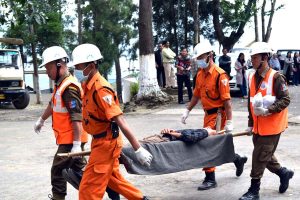Nagaland
Mock exercise: Same old lessons for Nagaland’s disaster response agency

Kohima Bureau
Kohima, April 26 (EMN): Although the ‘mega mock drill’ in the state was conducted successfully across the districts, it appears that improvements are yet to be made from the lessons learned from similar exercises in previous years.
As observers pointed out, today’s mock drill featured the same old problem of ‘inaudible sirens’ and ‘communication problems’.
It may be noted that, besides other concerns, two foresaid problems identified in the 2017 mock drill were highlighted by an officer of the NSDMA in the review meeting held on April 12. He had suggested that proper and permanent siren should be placed at strategic locations; and come up with a proper system of coordination for communications with more options.
In a briefing to highlight the ‘general observations’ of the mock drill, Chief Secretary Temjen Toy said the primary objective of the mock exercise was to examine the readiness of the state in the event of a disaster.
Toy identified ‘traffic’ as one of the main concerns while stating that even in normal circumstances it represents a problem. He asserted that traffic problems need to be looked into seriously and asked the traffic police to undertake a proper study in order to reduce ‘traffic bottlenecks’.
Toy also shared his disappointment that even after a lapse of one year, sirens have not been installed at appropriate locations as discussed. During the 2017 mock drill, sirens could not be heard in many locations of Kohima creating confusions among the citizens.
The chief secretary directed the NSDMA to identify appropriate and strategic locations to install the sirens which will be used only in times of disaster.
Another major concern, he pointed out, was communication. Terming the communication system as ‘really bad’, Toy mentioned that they were not able to communicate with other districts and communications were down even within Kohima.
Asserting that this needs to be examined, Toy directed NSDMA to look into this problem; upgrade its communication system; and also the communication between the various agencies.
Also observing that there was lack of communication and coordination between the State Emergency Operations Centre (SEOC) and ‘staging areas’, Toy said the channel of communication and the Standard Operating Procedure (SOP) need to be improved.
Citing some ‘stray incidents’, he maintained that SEOC need to have an overall picture of what is happening across the districts as it will be the information centre in case of emergency. He suggested working out a mechanism to utilise the resources available in the battalion headquarters in times of emergencies and also refuel various transport facilities.
Toy maintained that the state needs to have refuelling facility in case of a major disaster. He also reminded that NSDMA to be prepared and ready with stock of body bags, stating that while vendors have adequate number of coffins there were insufficient body bags in case of multiple deaths if an actual disaster were to occur.
Advisor, Pukhayi while appreciating all stakeholders for the successful conduct of the exercise reiterated the need for NSDMA to install sirens at strategic locations. Also stating that majority of the population lives in rural areas, he stressed on the need to create more awareness among the rural populace in the coming days.
National Disaster Management Authority (NDMA) joint advisor, Dhirendra Singh Sindhu talking on the sidelines of the briefing said that the 8.7 Mw magnitude of 1897 Shillong earthquake can cause immense destructions not only to the state of Nagaland but across northeast states.
When asked to share his views on today’s observation, he said no state can be fully prepared for such kind of disasters. However, he maintained that frequent conduct of such exercises could create more awareness among the people and prepare them for if and when disaster strikes.
Stating that it is the community who are the first responders in these exercises, Sindhu suggested that frequent exercises should be conducted in a proper way and opined that the state should come out with clear cut SOP and table top exercises. He also opined that only through practice, coordination among the various agencies can be achieved.

